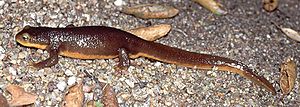California newt facts for kids
Quick facts for kids California newt |
|
|---|---|
 |
|
| Conservation status | |
| Scientific classification | |
| Kingdom: | |
| Phylum: | |
| Class: | |
| Order: | |
| Family: | |
| Genus: | |
| Species: |
T. torosa
|
| Binomial name | |
| Taricha torosa |
|
The California newt (Taricha torosa) is a type of newt that lives in California. It's also known as the orange-bellied newt because of its bright underside. These newts can grow up to 8 inches (20 cm) long. They have special toxic skin, which helps protect them from most animals. Because of this, the only animals that can safely eat a California newt are certain garter snakes.
Contents
What is a Newt?
Newts are a kind of amphibian. This means they can live both in water and on land. They are part of the salamander family. Newts often have rough, warty skin. They usually spend part of their lives in water, especially when they are young or when they are breeding.
Where Do California Newts Live?
California newts live only in the state of California. They can be found in many different places. These include forests, woodlands, and grassy areas. They like to be near streams, ponds, or lakes. This is because they need water for parts of their life cycle.
During the wet season, they are often found in water. They lay their eggs there. In the dry season, they might move to land. They often hide under rocks or logs to stay cool and moist.
Special Skin
The California newt has a secret weapon: its skin! Their skin produces a strong toxin called tetrodotoxin. This is the same powerful toxin found in pufferfish. If an animal tries to eat a newt, the toxin can make them very sick. It can even be deadly.
This toxin is a great defense. It means most predators learn to stay away from newts. The newt's bright orange belly also acts as a warning. It tells other animals, "Don't eat me, I'm poisonous!"
Who Are Their Enemies?
Even with their toxic skin, California newts have one main predator. This is the garter snake. Some garter snakes have developed a special ability. They are resistant to the newt's toxin. This means they can eat newts without getting sick.
Over many years, newts have become more toxic. At the same time, garter snakes have become more resistant. This is an example of an "evolutionary arms race." Both species are constantly changing to survive.
Different Kinds of California Newts
Within the California newt species, there are different types. These are called subspecies. They might look slightly different or live in specific areas.
Images for kids
See also
 In Spanish: Tritón de California para niños
In Spanish: Tritón de California para niños



